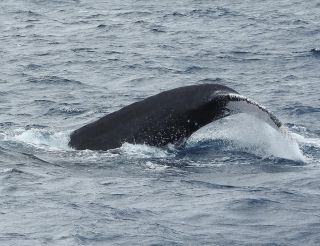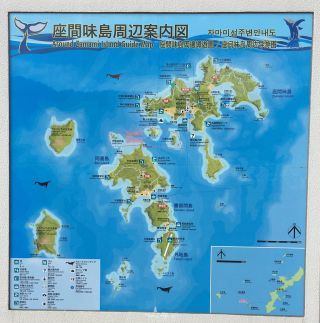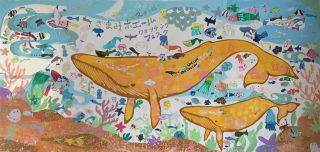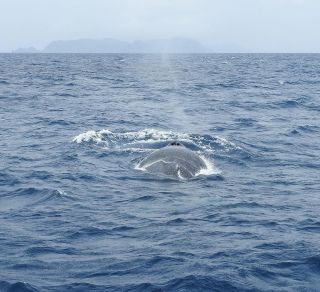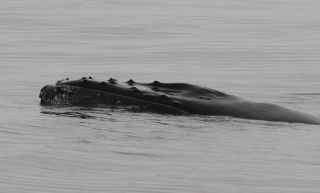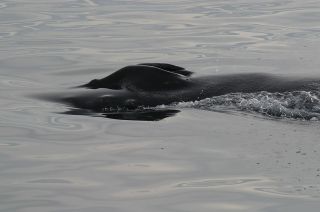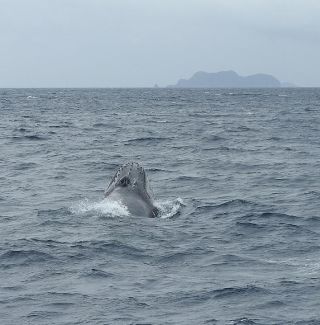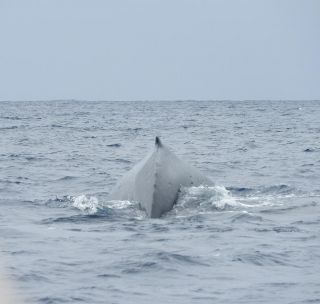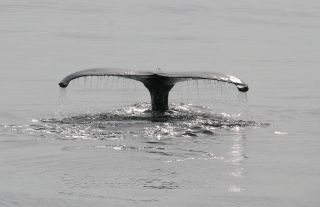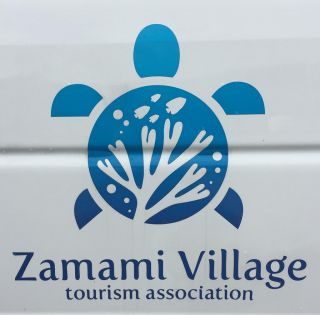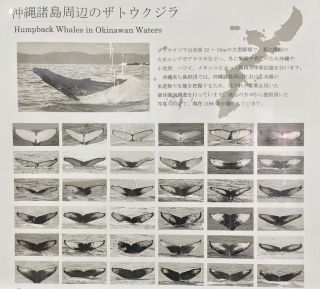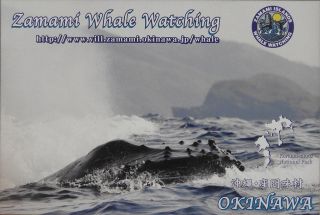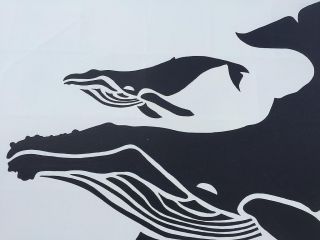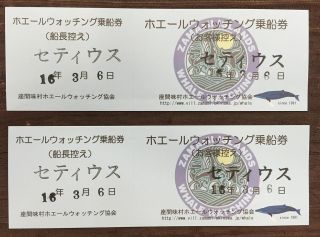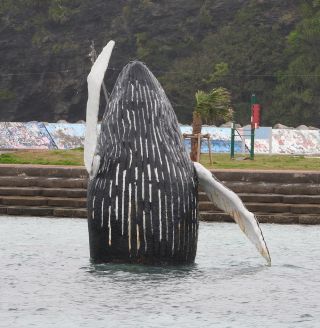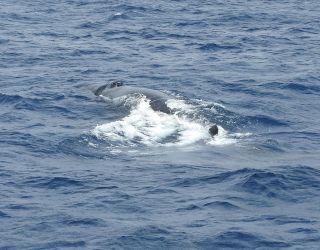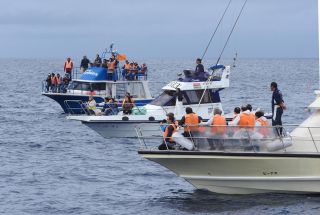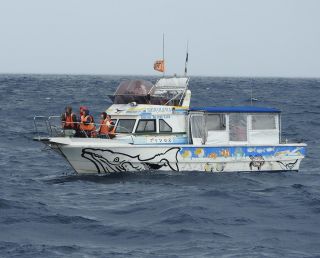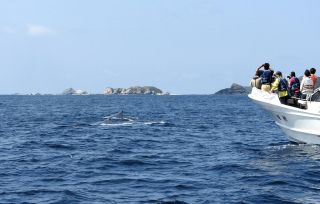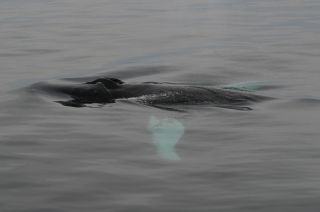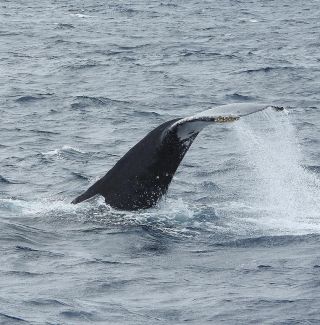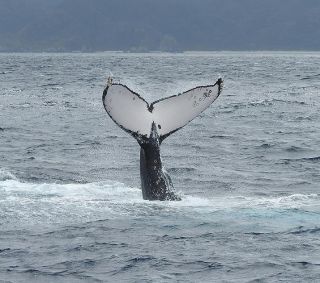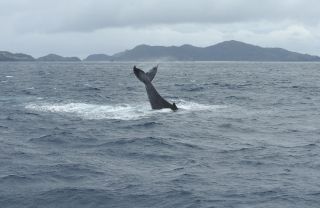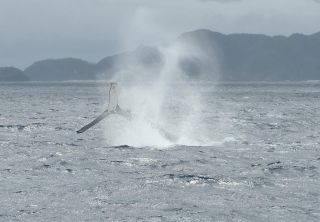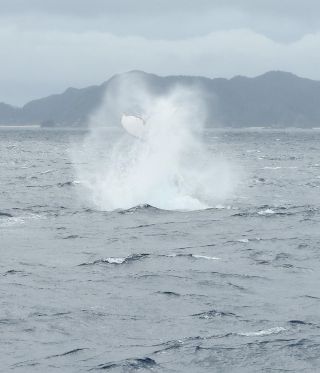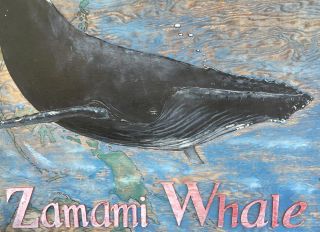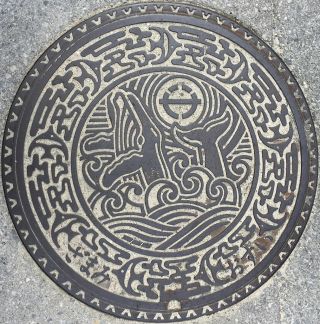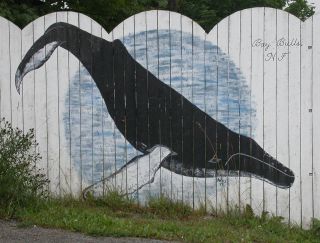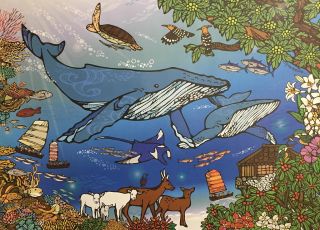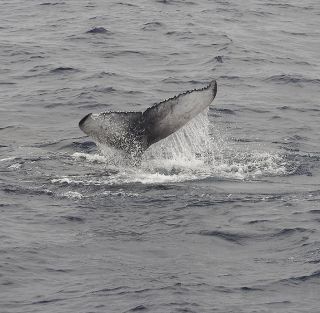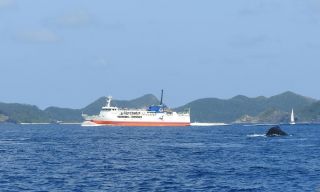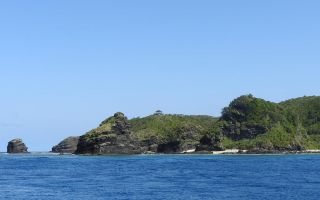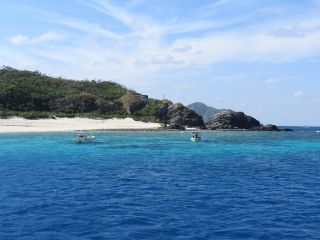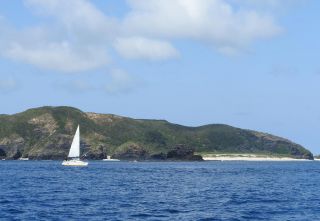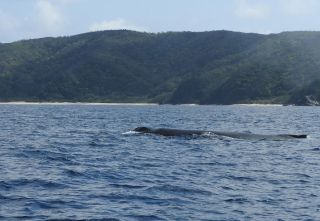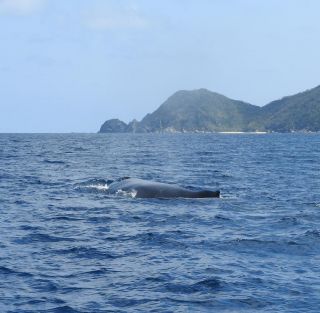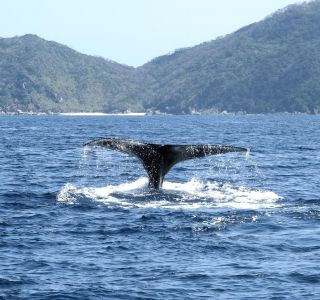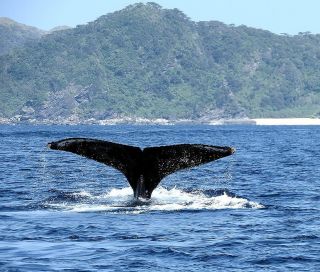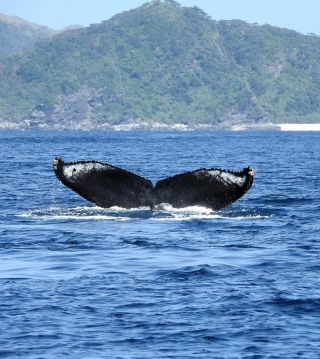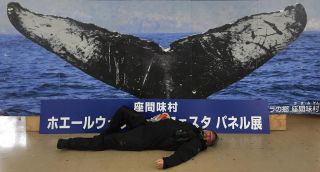And so begins my tale off Zamami © Mark Brazil
Whale Watching Japan-style: Zamami
By Mark Brazil | Mar 23, 2016
At long last I have made my pilgrimage to the tiny cluster of islands scattered in the sea to the west of Okinawa.
The Kerama Islands have been beckoning me for years, but at last, in early March this year, a brief personal window of opportunity, a few days between projects, and a very special invitation, coincided with a very crucial period, the winter months during which one can watch for whales off these southwestern islands of Japan.
The Kerama Islands and the Ogasawara Islands together can boast of being the calving grounds of one of the most dramatically active of all cetaceans – the Humpback Whale. While both archipelagos offer the relaxed atmosphere of a subtropical lifestyle, the Kerama Islands alone have the added flexibility of ready access. From Naha, the capital of Okinawa, there is a fast ferry, Queen Zamami, taking no more than an hour, and a regular service on Ferry Zamami taking 120 minutes, whereas the Ogasawara Islands accessible from Tokyo are for those on a week-long retreat by ship, as the ferry alone takes more than twenty-four hours each way.
My very first introduction to whales, at least the very first that I can recall, came while I was an undergraduate student at Keele University. I attended a class in Anglo-Saxon literature and one of our theme texts was the elegiac lament of a mariner who wrote of his feelings for the land and the sea some time between the 8th and 10th centuries. In what we now refer to as The Seafarer, the author described feelings and emotions that I could barely grasp as a landlubber student, but with which I can now empathise.
“Deep goes the mood that drives my soul / To fare from home, that, far away, / I may find the stead where strangers dwell…
So, now, my soul soars from my bosom, / The mood of my mind moves with the sea-flood, / Over the home of the whale, high flies and wide / To the ends of the earth; after, back to me / Comes the lonely flier, lustful and greedy, / Whets me to the whale-way, whelms me with his bidding / Over deep waters. Dearer, then, to me / The boons of the Lord than this life that is dead / In a land that passes; I believe no whit / That earthly weal is everlasting” [The Seafarer lines 36-38; 58-67].
It was only later, and unexpectedly, that the twisting path of my own life led me to spend lengthy periods at sea. There, amidst the salt tang, the ceaseless sound and the undauntable power of the waves I was to find that the “mood of my mind” also moved with the sea-flood. After reading The Seafarer I could never think of the sea other than as the “home of the whale” and as the “whale-way”. Each time I put to sea, and rode the whale-way, each languid hour I spent at a ship’s rail in search of seabirds skimming low over the wave tops my hopes were focussed on a dream, that from below those restless waves and into my view would erupt the blow of a whale.
Whale blows, the spouts, gouts and mists of moisture with which each large cetacean signals its returns to the interface with the air are something I have thrilled to watch from the Arctic to Antarctica. The power of the blow itself, its height, its angle and its structure (whether vertical, bushy or something in between) are giveaway features helping in the identification of each species.
I can honestly say that I have breathed in the breath of a whale. Although, in a sense so have we all – in as much as each outpouring of the lungs of a great whale co-mingles with the Earth's atmosphere, the very same air that we breathe. What I mean to say is that I have literally breathed in the breath of a whale, fresh from the whale’s exhalation straight into my lungs, the mist of its blow still raining gently about me, and no, it wasn’t unpleasant, it was wonderful! It was off the Kerama Islands.
Moments before, the great head of a Humpback Whale had lunged to the sea surface, one brief audible exhalation later and the whale’s back was disappearing, disappearing, then gone. So brief was the moment for inhalation following the blow that it seemed impossible that it had already re-charged its lungs and disappeared beneath the waves.
Moments later it was back, repeating the process, pumping out carbon dioxide, drawing in oxygen with which to recharge its lungs and its strength, and then again three times more in quick succession, blow dive, blow dive, blow, before finally thwarting all of us onlookers by diving without showing its tail flukes.
The excitement in spotting a whale’s flukes is palpable amongst whale onlookers (in fact frequently highly audible as many are reduced to whoops and whistles), not merely because of the enormous four metre spread of those flukes, but because careful observation and recording has shown that, like our finger prints, those flukes and the patterns that they carry are one individual’s alone, and they are carried for life.
When a whale dives without showing its flukes there is a sense among the watchers of being cheated out of the last act of a play, and of missing the finale. I was out to see flukes. Of course I was hoping for more, but flukes were as high as I dared hope.
In the case of the Kerama Islands, spotting a whale blow means one species and one alone, the Big-winged New Englander! The islands and especially the Zamami Village tourism association have taken this big-winged creature under their wing and justifiably promote the islands on their natural beauty and their wildlife (whales, turtles and other creatures of the sea are their key attractions).
Dubbed by scientists Megaptera novaeangliae, the Humpback Whale is a long-distance migrant. The Kerama Islands, like the Ogasawara Islands, lie at the southerly extreme of a route that the whales follow annually between food rich summer feeding grounds in the cold waters of the Bering Sea beyond the Aleutian Islands and their calving grounds in the warm subtropical waters around Japan’s southern island groups. Each year the same individuals plough the whale-way northwards in the spring from early April onwards, the females then accompanied by their rapidly growing offspring, and southwards in the autumn returning to the islands in late December to give birth once more. How do we know? Those fluke patterns tell much of the story.
Students of humpbacks are keen photographers and their goal is always to photograph the underside of the flukes and log them on line in databases that allow observers to compare and identify the individuals they have sighted, and low and behold the very same individuals have been found at different times of year in different parts of their range.
On the morning of 5 March, my wife Mayumi and I gathered with other whale fans, whale photographers and day-trippers in what could be dubbed the whale-way station – the ferry terminal at Zamami. There, Otsubo-san of the Zamami Whale Watching Association entertained us with his light-hearted but informative preliminary briefing about what lay ahead for us all as we joined the day’s quest.
Pointing initially at the white taped outline of a whale on the floor in front of us, Otsubo-san generated a group gasp at the realisation that it marked out only the shape and size of a one-ton baby! It was the very much larger blue taped outline spreading across much of the enormous room’s floor that indicated the full size and shape of a 30~40-ton mother. Nearby stood a life-size photograph of a humpback’s flukes showing their four to five metre span. Immediately we had a sense of perspective. We were going out looking for a monster of a mammal.
Following our brief introduction to their life cycle and their behaviour we were all assigned to the various boats going out whale-watching that morning. Ceteus was the vessel named on our tickets and soon we joined veteran captain Miyamura Yukifumi aboard his boat and set off for the sea. A new perspective was soon in place. These whales may be mega mammals, but the ocean into which we headed in search of them was a mighty big place; suddenly our search seemed to be for a drop in the ocean.
Scanning the horizon, seeking telltale bursts of vaporous breath, seemed the best plan and was certainly a wonderful way to admire the dramatic scenery of the archipelago as we skimmed by white sand beaches, lush greenery and black rock. After waiting years to visit the Kerama Islands during the winter whale window, I had imagined it might take several trips out to sea from Zamami before I was rewarded with a single whale sighting. While I scanned, and scanned, aching to be distracted by seabirds, flying fish or dolphins during our hunt for whales, our captain meanwhile was communicating with spotters onshore, they it transpired set out even earlier in search of whales from high vantage points and relay the information to the boats. They had already sighted our quarry and were sending us in their direction. To be honest, when told of the high likelihood of whale sightings, I had taken it all with a grain of salt, readily prepared for disappointment, yet within thirty minutes of leaving harbour we were in sight of whales (less if you count the huge whale monument in the harbour itself!).
As I scanned the distant horizon the unimaginable happened, a great shape erupted from the water into the air, half rolling as it did so before crashing down into an immense plume of spray; a moment later it was aloft again, but this time when it crashed down beneath the sea it was gone. It had been a long-range view, but I was stunned (and immensely grateful to be trying out powerful new Swarovski binoculars). Those distant views of a whale breaching and of another slapping its long pectoral fins several times on the surface were soon pushed down my mental ranking of sightings as we came up very much closer on two more animals. I had hoped for flukes and those we saw aplenty, but we were fortunate and there was so much more to see.
The overcast sky lent the sea a leaden, grey appearance and from this greyness emerged the great, grey back of a whale ahead of us; it rolled, showing off the nub of a dorsal fin that is a trademark feature of the Humpback Whale. Sometimes, this short, invariably stubby, fin is curved, even falcate, but sometimes nicked or marked as if by close encounter. As the whale arched its enormous back I could make out the lumpy processes of its lower spine as I admired the abruptly tapering stock of its tail. We followed cautiously, keeping behind and to the side of the whale’s motion so as always to give it the wide ocean to move towards should it tire of our presence.
The ruffled surface of the sea and the overcast sky made it impossible for me to see down through the water, but nevertheless I peered and peered hoping to admire its long pale underwater “wings” and to spot the nodules and barnacle clusters along their leading edges, as I had once before when whale-watching off Newfoundland. It was not to be, but instead “our” whale suddenly lunged forward raising its head from the water as it did so and showing of the strange nodules atop its head then its massive paired nostrils and the wedge-shaped splashguard ahead of them. It exhaled once more then was gone. Wow! The excitement on board was amazing, there were grins all round, there were high fives, and whoops of delight. It was all in a day’s work for our captain.
In a regularly repeated pattern, the captain, his spotter Ms Shinpou, or one of us on board, would sight a whale blow and shout out its direction. Turning in pursuit, we set off and did our best to catch up with it during the short period it took the whale to emerge, breathe and submerge three to five times in quick succession. Sometimes we made it; sometimes it was long gone before we could approach. We felt like a mouse being led on by an enormous cat. Occasionally we arrived in time for a treat, and on our very first trip out we had a stunning treat.
The main animal that we followed on that first outing seemed heaven bent on putting on a display. As its flukes came up and showed clearly for the first time I thought that I heard Shinpou-san shout “Snoopy”. I was distracted in my attempt to photograph it and assumed that I had misheard, I certainly could not imagine a link. It was only later, after hearing an explanation for the nickname and on checking my photographs, that I half understood the reference. To a forgotten observer, many years ago, it seemed that the black spot near the base of the right fluke recalled the famous cartoon character’s nose, the initial observer’s nickname has somehow stuck, sadly though none of the crews seemed to remember who had given the name.
It was indeed Snoopy. Over and over again he not merely dove showing of his almost pure white flukes, but he lashed and thrashed at the water. Floating vertically with his head down deep he battered and bashed at the sea surface with the underside of his tail; each time it came down with a mighty crash. Then, as if to stretch out his back, he switched to battering with the upper surface of his tail, before lunging half out of the water and thrashing repeatedly not just with his flukes or tail base, but seemingly half of his body; the noise was incredible. It was an amazing show, my scepticism about the likelihood of finding whales was long gone, and it had been a red-letter day, furthermore it was only half done.
Our plans were to return to sea for a second whale watching trip that day, but Ceteus was so delayed returning that the briefing for the next outing was already underway when we reached the terminal and we would have needed to turn straight back round and head out again immediately, so instead we opted for further exploration of the delightful archipelago including a trip across to Aka, Geruma and Fukaji islands in search of history, traditional architecture and the mysterious Kerama Deer, but that is another story.
A fascination and pleasure of touring Japan is the attention to detail encountered in so many small ways throughout the country, from omotenashi to the tidiness and the artistry – even on the streets beneath your feet. Keeping a sharp eye open for anything artistic relating to whales, we had immediately spotted the wonderful design on the local ferry, and the carved wooden plaque outside the ‘whaleway station’, but while strolling the narrow streets of the Zamami community Mayumi and I came across a uniquely Japanese feature – decorated manhole covers.
To date I haven’t noted any exciting drain covers overseas, but municipalities and local communities from Hokkaido to Okinawa sport some extraordinary combinations of the utilitarian and the artistic. I have seen manhole covers depicting kneeling archers, others adorned with birds, some with fish, and they are not only artistic, in some communities they are even colourful, as they are seemingly enamelled! The Kerama Islands are no exception to the artistic trend of Japanese communities, though I missed out on any coloured ones (if they exist there).
To say that Japan’s manhole covers are cool would be merely to echo the sentiments of hundreds of websites – some of which are specifically devoted to “drainspotting”. Japan’s manhole covers are not just cool, they are absolutely stunning and an immediate hit with travellers. Drainspotting here is so much fun that the Japanese tourist board really should make a big deal of it in their national advertising.
Drainspotting, is like birdwatching, it is something you can do pretty much everywhere, as long as you are in Japan! On Zamami Island the local manhole covers carry wonderfully depictions of Humpback Whales, while just across the way on Aka and Geruma islands they carry images of the local Kerama Deer.
The manhole covers are not the only evidence of whale mania in the Kerama Islands. Although I had half expected to come across murals on house walls or fences as I had in Newfoundland they were strangely lacking. I did however spot one high on a pension wall on Aka Island, and another on the nearby harbour wall, but there seemed plenty of room to enliven the somewhat generic and drab local domestic architecture of the islands.
Someone more than capable of enlivening the scene is the Okinawan artist “Pokke104” whose depictions of the islands and their wildlife are beyond charming. We encountered her works in the tourist information office and gift shop and in a poster advertising an annual whale watching festival. But my goodness, if she was a Banksy the town could sport some amazing wall art in her vibrant colours and distinctive style.
On 6 March the islands were shrouded in low cloud, with a light rain falling, but undeterred Mayumi and I set off on our morning walk to explore a little of Zamami Island from our base at the Kerama Beach Hotel. Within twenty minutes our walk had turned from a stroll into a rescue mission. Tempted out by the night’s dampness, dozens of newts were on the move. Blind to the depths of the roadside culverts and unknowing of their vertical sides many had fallen and were trapped where later sunshine would dry them out and kill them. Our stroll became slower as I stooped and retrieved Sword-tailed Newts from slow demise in the deep concrete culverts beside the country road – a little more thought in the design of those culverts could easily have averted a death toll.
Light rain was falling, drawing a faint veil across the islands, as we set off aboard Ceteus again that morning, and the weather might so easily have been echoed in our mood, but the whales were on show again. Before we knew it we were drawn in to the daily drama of the whale show. We were in roughly the same area of the sea to the northwest of the islands, but today we lucked into a female with her calf. While she dove repeatedly in the pattern we had learned the day before, disappearing for ten to fifteen minutes at a time, the youngster, a fraction of her size and just a month or so old, dove for briefer periods barely longer than five minutes, allowing us plenty of viewing time. The great event was so brief, so un-photographable, yet it is still etched in the camera obscura of my mind. In one glorious, choreographed moment, mother and youngster took to the air! They lunged up and out of the water in perfect synchrony in full breach; then they crashed back into their real world leaving all of us on board Seteus gasping. A moment later the youngster alone repeated the feat, as if to convince us that its abilities had not been a fluke. [That one is for you Ian Redmond!]
It was hard to imagine capping our dramatic morning’s successes, but we were certainly willing to try as we set off aboard Gobies that afternoon, but the weather clamped down and after an hour of lashing rain and terrible visibility we had to admit defeat. We might have been stationary in the midst of whale blow and we wouldn’t have known, so we headed back to port and vowed to try again the following morning.
Monday 7 March provided the weather we had dreamed of, it was bright, sunny and almost cloudless as we set off for our morning stroll admiring the freshly blooming Kerama Azaleas in sunshine for the first time.
With fewer day-trippers arriving this morning off the ferry from Naha, we boarded the smaller Beagle III and set off once more this time for our fourth and final opportunity for whales. Once again we set off for the ever-popular northwestern area, but suddenly we slowwed down, turned and headed back then past the harbour leaving it behind us as we headed for the waters between the islands. The spotter above on Zamami clearly had fresh information.
It was a gorgeous day in which to revel in the beauty of the marine scene and I sorely wished that I had more time and my snorkelling gear with me so that I could explore the islands beneath the waves. It was a day when the term Kerama Blue truly came into its own, with radiant sunlight angling through the shallow waters over the white coral sand the sea took on a beautiful shade of limpid cerulean. I could only imagine plunging into it and watching the colourful fish below.
With Aka-jima to our left and Tokashiki-jima to our right we explored northwards up the almost enclosed waters and soon we spotted blows. The rest of the morning was devoted to following the two adults that we had encountered, but there were others about, with blows further north, an individual that was surprisingly close to the shore of Tokashiki-jima to the east and one that steamed past us heading south as if it was on a mission. It was difficult to keep track of them – after all being confined above the waves we missed the 95% of the whale activity that took place below, and could only imagine the action and interactions down there – but I estimated that we saw six or seven at least.
It would have been marvelous to have the Zamami boats equipped with hydrophones (if there is a wealthy benefactor reading out there, it would be delightful to provide them to further the education of the many guests), then all on board would have been equally enchanted by their sounds even when the whales were out of sight. If you would like a taste of the wonderful “songs” of the humpbacks follow this link (Humpback Whale Song) or you can download whale songs from the Ocean Mammal Institute.
Humpback males sing some of the most complex songs of any creature on Earth and though long considered silent, females are now thought to produce remarkably deep “pulse-trains” as this National Geographic Humpback Whale link reveals.
On that calmer final morning in Kerama we followed the whales back and forth, admiring their many physical adaptations to their environment that made it so easy for them to elude us and so difficult for us to follow them. In the calm seas we watched them raising their flukes into the air, flagging their IDs at us, then as they dived beneath us the up-thrust of their tails driving water toward the surface left behind tell-tale calm patches, ripple-less discs of quiet ocean surface. These calm spots are dubbed whale footprints.
We followed in the footprints of the Humpback Whales that day, and I wished I could have stayed to follow their prints as they set off on their annual spring journey northwards exploring the western Pacific on their way to the Bering Sea. They will set out in the first weeks of April, but the whale spotters of Kerama will be waiting for their return in December. I hope to join them again one day.
Outro
If you have read this far, then you may enjoy my previous articles, including recent offerings such as: "Snow Monkeys & Cranes of Japan: Spectacular Winter Wildlife" (February 2016), “Amami Night Safari” (January 2016) “Life at the Water’s Edge” (December 2015), and “The Bird that Saved Me from Death” (November 2015). These and many more can be found on this website, and on our Facebook page (please do visit and hit the “Like” button).
Author and naturalist Dr Mark Brazil has written his Wild Watch column continuously since April 1982. All Wild Watch articles dating back to 1999 are archived here for your reading pleasure. A collection of Mark’s essays The Nature of Japan and two handy pocket guides The Common and Iconic Birds of Japan and The Common and Iconic Mammals of Japan have been published and are also available from www.japannatureguides.com

